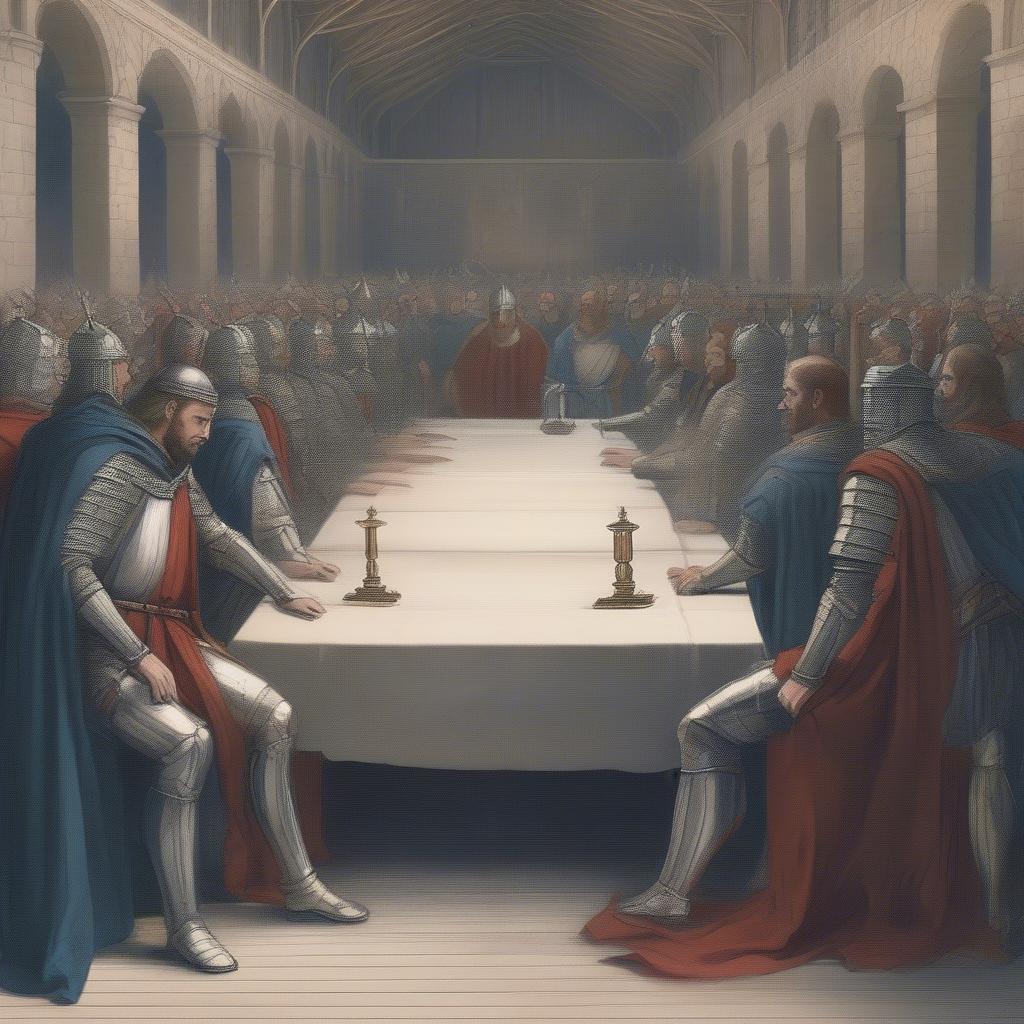
The Magna Carta, a cornerstone of individual liberties and constitutional law, often raises the question: Who Signed The Magna Carta? The answer, as with much of history, isn’t straightforward. While King John’s seal is prominently displayed, the concept of individual signatures as we know it today didn’t exist then. Instead, the document was sealed, not signed, representing the agreement of the involved parties. This article delves into the complex circumstances surrounding the Magna Carta’s creation in 1215, exploring the key figures who played a role in its sealing and its enduring significance.
Table Content:
- The Key Players: Beyond Just King John
- The Rebellious Barons: Champions of Liberty?
- King John: A Reluctant Signatory
- The Magna Carta’s Legacy: Echoes Through History
- From Medieval England to Modern Democracy
- The Evolution of Rights and Liberties
- The Sealing, Not Signing: Understanding Medieval Practices
- The Significance of the Seal
- Conclusion: More Than Just Signatures
- FAQ
The Key Players: Beyond Just King John
While King John is inextricably linked to the Magna Carta, it’s crucial to understand that its creation wasn’t solely his decision. Powerful barons, disgruntled with his rule, forced his hand. These barons, representatives of the English nobility, sought to limit the king’s power and assert their own rights. While no individual signatures exist, their collective pressure resulted in the sealing of the document. The Magna Carta, therefore, represents a power struggle, a compromise forged between a reluctant king and a determined aristocracy.
The Rebellious Barons: Champions of Liberty?
The barons who compelled King John to seal the Magna Carta weren’t solely driven by altruistic motives. Their concerns stemmed from issues like excessive taxation, feudal obligations, and the arbitrary exercise of royal power. Figures like Robert FitzWalter, leader of the baronial army, played a crucial role in the negotiations. While seeking to protect their own interests, their actions inadvertently laid the foundation for future concepts of individual liberties and limited government.
King John: A Reluctant Signatory
King John’s association with the Magna Carta is often portrayed negatively, painting him as a tyrannical ruler. However, understanding the political context is crucial. John faced pressures from multiple fronts, including conflicts with France and the papacy. The Magna Carta became a bargaining chip in these complex power struggles, a necessary concession to appease the rebellious barons and maintain a semblance of control.
The Magna Carta’s Legacy: Echoes Through History
The Magna Carta’s impact extends far beyond its immediate historical context. It laid the groundwork for fundamental principles like habeas corpus and due process, influencing legal systems worldwide. Who signed the Magna Carta is less important than the document’s lasting influence on the development of democratic ideals and the rule of law.
From Medieval England to Modern Democracy
The Magna Carta’s principles, though initially intended for a specific historical context, have resonated through the ages. Its emphasis on limiting arbitrary power and protecting individual rights has inspired constitutional movements across the globe. The document’s legacy continues to shape our understanding of justice and governance.
 Magna Carta's Legacy in Modern Democracy
Magna Carta's Legacy in Modern Democracy
The Evolution of Rights and Liberties
The Magna Carta wasn’t a perfect document, nor did it instantly establish a fully functioning democracy. It represented a crucial step in the ongoing evolution of human rights and liberties. Its principles have been reinterpreted and adapted over centuries, shaping the legal and political landscape we inhabit today.
“The Magna Carta serves as a powerful reminder that the pursuit of justice and liberty is a continuous process,” observes Dr. Eleanor Ainsworth, medieval historian at the University of Cambridge.
The Sealing, Not Signing: Understanding Medieval Practices
It’s essential to clarify that the notion of individual signatures on the Magna Carta is a modern misconception. In 1215, official documents were authenticated with seals, not signatures. King John’s Great Seal affirmed the document’s authority. The absence of individual baronial seals further emphasizes the collective nature of their action against the King.
The Significance of the Seal
The seal affixed to the Magna Carta wasn’t merely a decorative element. It symbolized the royal authority and the binding nature of the agreement. The act of sealing represented a solemn commitment, a public declaration of the terms agreed upon by the king and the barons.
Conclusion: More Than Just Signatures
While the question of who signed the Magna Carta persists, the focus on signatures obscures the document’s true significance. The Magna Carta, sealed under duress by King John, represents a pivotal moment in the struggle for power and the development of individual liberties. It serves as a testament to the enduring power of collective action and the ongoing quest for a more just and equitable society.
FAQ
- Was the Magna Carta signed? No, it was sealed with King John’s Great Seal.
- Who forced King John to seal the Magna Carta? The rebellious English barons, seeking to limit his power.
- What was the purpose of the Magna Carta? To restrict the King’s authority and assert the rights of the barons.
- What is the legacy of the Magna Carta? It influenced the development of legal systems and democratic ideals worldwide.
- Why is the Magna Carta considered important today? It laid the groundwork for principles like habeas corpus and due process.
- How did the Magna Carta impact the evolution of human rights? It marked a significant step towards limiting arbitrary power and protecting individual liberties.
- What is the significance of King John’s seal on the Magna Carta? It symbolized royal authority and the binding nature of the agreement.
